Plot summary
Elias Henders is the prosperous owner of a ranch and a gold mine. Competing for his daughter Diana, ranch hand Colby sabotages recovering alcoholic foreman Bull, and takes his job. The local stage is repeatedly robbed of gold bullion from the owner's mine, and Bull is suspected. The cowardly sheriff does not take action on the robberies. Rich Easterner Wainwright tries to buy the mine and ranch for a low price, but Henders refuses the offer and discusses the property's true value with Diana. She is intrigued by Wainwright's Eastern-educated son Jefferson, who proposes marriage. However, when they are attacked by Indians during the roundup, he runs rather than defend her. Henders is mortally wounded in the battle.
Henders will bequeaths his property to his brother John back East so that he can take care of Diana, but John dies too. The Wainwrights pretend that Henders had agreed to a sale, but Diana knows better. Diana's Eastern cousin Lillian brings Corson, a lawyer, to try to seize the ranch and gold mine. They insist that the ranch and mine are nearly played out, and that they should sell the property, offering her a small amount. They show their ignorance about western ways. Bull encourages Diana that the property is worth more than they say, and advises her that the Wainwrights are often at the mine. The Eastern lawyer finally announces that Diana has no property rights due to the wills.
As pressure from the opposing forces builds, a mob goes to hang Bull for the stage robberies, but Diana warns him in time. Bull discovers there are papers that will prove Diana's claim to the property, and that Lillian has seduced Colby to obtain his help. Bull actually does rob the stage, simply to obtain the papers supporting Diana. Diana recognizes him at the robbery, and is devastated because she is starting to have feelings for him. She orders the Wainwrights, Lillian and Corson off the property, and fires Colby.
Bull has the Mexican Gregorio deliver the important papers to Diana, showing that Lillian is not related to John and thus not entitled to the property. The villains try to take over the ranch. Bull catches Colby robbing the bullion stage, and has him watched in town, but he is released by the sheriff and his friends. Colby kidnaps Diana and heads for Mexico. He claims to be rescuing her, but she knows that she does not love him. Bull follows her doggedly, and eventually rescues her. They return to town, stop the illegal title transfers and announce their impending marriage.

Edgar Rice Burroughs was an American speculative fiction writer, best known for his prolific output in the adventure, science fiction and fantasy genres. His most well-known creations include Tarzan of the Apes, John Carter of Mars and Carson Napier of Venus.

Tarzan and the Leopard Woman is a 1946 action film based on the Tarzan character created by Edgar Rice Burroughs and portrayed by Johnny Weissmuller. Directed by Kurt Neumann, film sees Tarzan encounter a tribe of leopard-worshippers. It was shot in the Los Angeles County Arboretum and Botanic Garden. Its plot has nothing in common with the 1935 novel Tarzan and the Leopard Men.
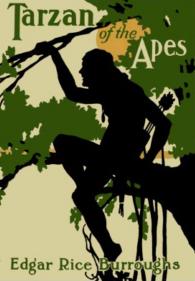
Tarzan of the Apes is a 1912 novel by American writer Edgar Rice Burroughs, the first in a series of twenty-four books about the title character Tarzan. It was first published in the pulp magazine The All-Story in October 1912 before being released as a book in 1914.
Opar is a fictional lost city in the Tarzan novels of Edgar Rice Burroughs and later the Khokarsa novels of Philip José Farmer and Christopher Paul Carey and various derivative works in other media. The city first appeared in the second Tarzan novel, The Return of Tarzan (1913).

Sabor is a generic name for African lionesses in Mangani, the fictional language of the great apes in the Tarzan novels of Edgar Rice Burroughs. In Burroughs' works several lionesses appear under the designation Sabor. In the Disney animated movie Tarzan, Sabor is a term for leopards, more specifically the leopard that kills Tarzan's parents.
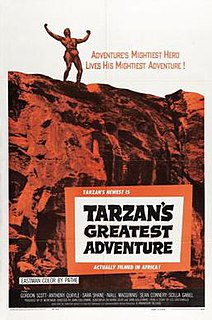
Tarzan's Greatest Adventure is a 1959 Eastmancolor adventure film directed by John Guillermin, produced by Sy Weintraub and Harvey Hayutin, and written by Les Crutchfield, based on the character created by Edgar Rice Burroughs. With a strong supporting cast that included Anthony Quayle and Sean Connery, and a focus on action and suspense, the film won critical praise as a Tarzan film that appealed to adults as well as children.
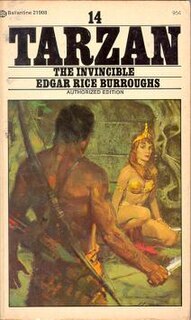
La is a character in Edgar Rice Burroughs's series of Tarzan novels, the queen and high priestess of Opar, a lost city located deep in the jungles of Africa. Opar is portrayed as a surviving colony of ancient Atlantis in which incredible riches have been stockpiled down through the ages. The city's population exhibits extreme sexual dimorphism caused by a combination of excessive inbreeding, cross-breeding with apes, and selective culling of offspring. Consequently, female Oparians are physically perfect, while male Oparians are hideous bestial creatures.

Tarzan the Untamed is a book by American writer Edgar Rice Burroughs, the seventh in his series of twenty-four books about the title character Tarzan. It was originally published as two separate stories serialized in different pulp magazines; "Tarzan the Untamed" in Redbook from March to August, 1919, and "Tarzan and the Valley of Luna" in All-Story Weekly from March to April 1920. The two stories were combined under the title of the first in the first book edition, published in 1920 by A. C. McClurg. In order of writing, the book follows Jungle Tales of Tarzan, a collection of short stories about the ape-man's youth. Chronologically, it follows Tarzan and the Jewels of Opar.

Tantor is a generic name for elephants in Mangani, the fictional language of the great apes in the Tarzan novels of Edgar Rice Burroughs. In Burroughs's works a number of elephants appear under the name of Tantor, most notably one particular bull elephant the ape man befriends in his youth in the first Tarzan novel, Tarzan of the Apes.

Tarzan and the Jewels of Opar is a novel by American writer Edgar Rice Burroughs, the fifth in his series of twenty-four books about the title character Tarzan. It first appeared in the November and December issues of All-Story Cavalier Weekly in 1916, and the first book publication was by McClurg in 1918.

Jungle Tales of Tarzan is a collection of twelve loosely connected short stories by American writer Edgar Rice Burroughs, comprising the sixth book in order of publication in his series of twenty-four books about the title character Tarzan. Chronologically the events recounted in it occur within Chapter 11 of the first Tarzan novel, Tarzan of the Apes, between Tarzan's avenging of his ape foster mother's death and his becoming leader of his ape tribe. The stories ran monthly in Blue Book magazine, September 1916 through August 1917 before book publication in 1919.

Tarzan the Terrible is a novel by American writer Edgar Rice Burroughs, the eighth in his series of twenty-four books about the title character Tarzan. It was first published as a serial in the pulp magazine Argosy All-Story Weekly in the issues for February 12, 19, and 26 and March 5, 12, 19, and 26, 1921; the first book edition was published in June 1921 by A. C. McClurg. Its setting, Pal-ul-don, is one of the more thoroughly realized "lost civilizations" in Burroughs' Tarzan stories. The novel contains a map of the place as well as a glossary of its inhabitants' language.

Tarzan and the City of Gold is a novel by American writer Edgar Rice Burroughs, the sixteenth in his series of twenty-four books about the title character Tarzan. The novel was originally serialized in the magazine Argosy from March through April 1932.

The Romance of Tarzan is a 1918 American silent action adventure film directed by Wilfred Lucas starring Elmo Lincoln, Enid Markey, Thomas Jefferson, and Cleo Madison. The movie was the second Tarzan movie ever made, and is based on Edgar Rice Burroughs' original 1912 novel Tarzan of the Apes. It adapts only the second part of the novel, the earlier portion having been the basis for the preceding film Tarzan of the Apes (1918). Less popular than its predecessor due to much of the action taking place in the wild west rather than Africa, the film has not been preserved, and no prints of it are known to survive today.
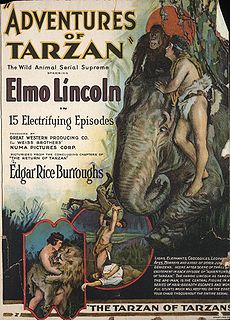
The Adventures of Tarzan (1921) is a 15 chapter movie serial which features the third and final appearance of Elmo Lincoln as Tarzan. The serial was produced by Louis Weiss, written by Robert F. Hill and Lillian Valentine, and directed by Robert F. Hill and Scott Sidney. The first chapter was released on December 1, 1921.
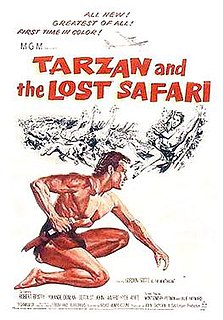
Tarzan and the Lost Safari is a 1957 action adventure film featuring Edgar Rice Burroughs' famous jungle hero Tarzan and starring Gordon Scott, Robert Beatty, Yolande Donlan and Betta St. John. Directed by H. Bruce Humberstone, it was the first Tarzan film released in color, Eastman Color. It was also MGM's first Tarzan film since 1942 and filmed in Nairobi, British East Africa. The character of Jane does not appear in this motion picture.

The Mucker is a novel by American writer Edgar Rice Burroughs. It was originally formed by two stories: "The Mucker", begun in August 1913 and published by All-Story Weekly in October and November 1914; and "The Return of the Mucker", begun in January 1916 and published by All-Story Weekly in June and July 1916. The book version was first published by A. C. McClurg on 31 October 1921. From January 1922 to August 1939, Methuen (UK) published a version of The Return of the Mucker under the title The Man Without a Soul.
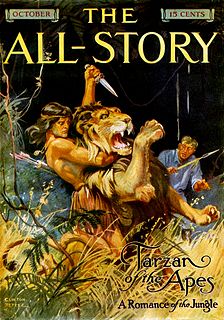
Tarzan is a fictional character, an archetypal feral child raised in the African jungle by the Mangani great apes; he later experiences civilization only to reject it and return to the wild as a heroic adventurer. Created by Edgar Rice Burroughs, Tarzan first appeared in the novel Tarzan of the Apes, and subsequently in 25 sequels, several authorized books by other authors, and innumerable works in other media, both authorized and unauthorized.

The Girl from Hollywood is an Edgar Rice Burroughs contemporary fiction novel. The Girl from Hollywood was published as a serial by Munsey's Magazine from June to November, 1922. The book version was first published by Macaulay Co. on 10 August 1923.

Tarzan is a series of 24 adventure novels written by Edgar Rice Burroughs (1875–1950) and published between 1912 and 1966, followed by several novels either co-written by Burroughs, or officially authorized by his estate. There are also two works written by Burroughs especially for children that are not considered part of the main series.


















